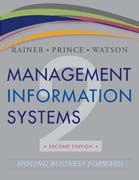
The 2nd edition supports teaching goals by allowing for maximum flexibility of coverage, and by engaging students with a tested pedagogical structure. Utilizing flexible Learning Units comprised of tightly coupled concepts and Student Activities, the authors transport students from passively learning about IS to doing IS in a realistic context. Plug IT In learning extensions enable instructors to introduce material of interest at their discretion. Plug IT In ?s cover such topics as project management, business processes, information asset protection. INDICE: Chapter 1 Introduction to Information Systems 2 1.1 Why Should I Study Information Systems? 5 1.2 Overview of Computer–Based Information Systems 12 1.3 How Does IT Impact Organizations? 22 1.4 Why Are Information Systems Important to Society? 25 Chapter 2 Organizational Strategy, Competitive Advantage, and Information Systems 42 2.1 Business Pressures, Organizational Responses, and IT Support 45 2.2 Competitive Advantage and Strategic Information Systems 56 2.3 Business–IT Alignment 63 Chapter 3 Data and Knowledge Management 78 3.1 Managing Data 81 3.2 The Database Approach 85 3.3 Database Management Systems 91 3.4 Data Warehouses and Data Marts 97 3.5 Knowledge Management 105 Chapter 4 Telecommunications and Networking 122 4.1 What Is a Computer Network? 125 4.2 Network Fundamentals 128 4.3 The Internet and the World Wide Web 134 4.4 Network Applications 140 Chapter 5 Business Intelligence 168 5.1 Managers and Decision Making 171 5.2 What Is Business Intelligence? 176 5.3 Business Intelligence Applications for Data Analysis 180 5.4 Business Intelligence Applications for Presenting Results 183 5.5 Business Intelligence in Action: Corporate Performance Management 190 Chapter 6 Ethics and Privacy 202 6.1 Ethical Issues 204 6.2 Privacy 209 Chapter 7 Information Security 226 7.1 Introduction to Information Security 229 7.2 Unintentional Threats to Information Systems 231 7.3 Deliberate Threats to Information Systems 235 7.4 What Organizations Are Doing to Protect Information Resources 243 7.5 Information Security Controls 245 Chapter 8 Social Computing 272 8.1 Web 2.0 275 8.2 Fundamentals of Social Computing in Business 283 8.3 Social Computing in Business: Shopping 286 8.4 Social Computing in Business: Marketing 293 8.5 Social Computing in Business: Customer Relationship Management 301 8.6 Social Computing in Business: Human Resource Management 303 8.7 Crowdsourcing 307 Chapter 9 E–Business and E–Commerce 324 9.1 Overview of E–Business and E–Commerce 328 9.2 Business–to–Consumer (B2C) Electronic Commerce 335 9.3 Business–to–Business (B2B) Electronic Commerce 346 9.4 Ethical and Legal Issues in E–Business 348 Chapter 10 Wireless, Mobile Computing, and Mobile Commerce 364 10.1 Wireless Technologies 367 10.2 Wireless Computer Networks and Internet Access 374 10.3 Mobile Computing and Mobile Commerce 383 10.4 Pervasive Computing 390 10.5 Wireless Security 395 Chapter 11 Information Systems Within the Organization 408 11.1 Transaction Processing Systems 410 11.2 Functional Area Information Systems 412 11.3 Enterprise Resource Planning Systems 419 11.4 Reports 424 Chapter 12 Extending the Organization to Customers 436 12.1 Defining Customer Relationship Management 439 12.2 Operational Customer Relationship Management Systems 443 12.3 Analytical Customer Relationship Management Systems 449 12.4 Other Types of Customer Relationship Management Systems 450 Chapter 13 Extending the Organization Along the Supply Chain 466 13.1 Supply Chains 468 13.2 Supply Chain Management 471 13.3 Information Technology Support for Supply Chain Management 476 Chapter 14 Acquiring Information Systems and Applications 490 14.1 Planning for and Justifying IT Applications 493 14.2 Strategies for Acquiring IT Applications 497 14.3 The Traditional Systems Development Life Cycle 503 14.4 Alternative Methods and Tools for Systems Development 511 14.5 Vendor and Software Selection 517 Plug IT In 1 Business Processes and Business Process Management 530 PI1.1 Business Processes 530 PI1.2 Business Process Reengineering and Business Process Management 535 Plug IT In 2 Hardware and Software 539 PI2.1 Introduction to Hardware 540 PI2.2 Introduction to Software 551 Plug IT In 3 Cloud Computing 561 PI3.1 Introduction 562 PI3.2 What Is Cloud Computing? 563 PI3.3 Different Types of Clouds 568 PI3.4 Cloud Computing Services 569 PI3.5 Cloud Computing Benefits 573 PI3.6 Concerns and Risks with Cloud Computing 576 PI3.7 Web Services and Service–Oriented Architecture 579 Plug IT In 4 Intelligent Systems 586 PI4.1 Introduction to Intelligent Systems 586 PI4.2 Expert Systems 589 PI4.3 Neural Networks 593 PI4.4 Fuzzy Logic 595 PI4.5 Genetic Algorithms 595 PI4.6 Intelligent Agents 596 Plug IT In 5 Project Management 601 PI5.1 Project Management for Information Systems Projects 601 PI5.2 The Project Management Process 603 PI5.3 The Project Management Body of Knowledge 605 Plug IT In 6 Protecting Your Information Assets 612 PI6.1 How to Protect Your Assets: The Basics 612 PI6.2 Behavioral Actions to Protect Your Information Assets 613 PI6.3 Computer–Based Actions to Protect Your Information Assets 616 Photo Credits 635 Index 636
- ISBN: 978-1-118-44359-0
- Editorial: John Wiley & Sons
- Encuadernacion: Rústica
- Páginas: 672
- Fecha Publicación: 04/07/2013
- Nº Volúmenes: 1
- Idioma: Inglés
- Inicio /
- /
